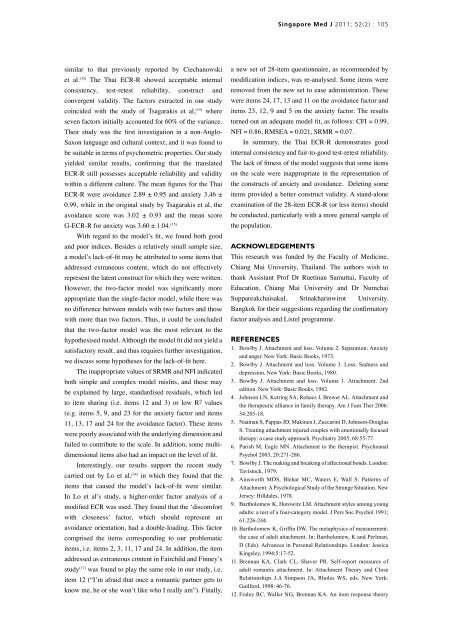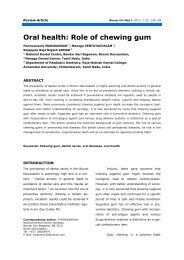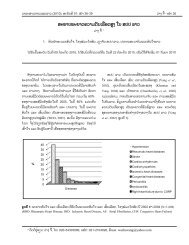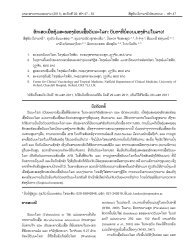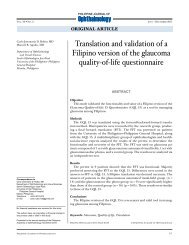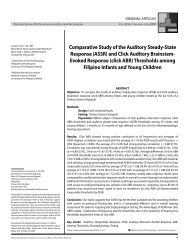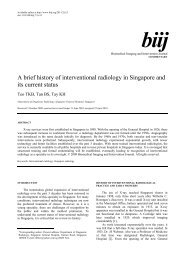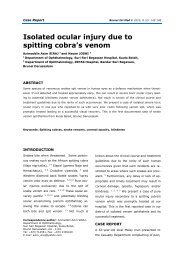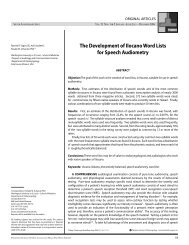Validity and reliability of the Thai version of the ... - ResearchGate
Validity and reliability of the Thai version of the ... - ResearchGate
Validity and reliability of the Thai version of the ... - ResearchGate
Create successful ePaper yourself
Turn your PDF publications into a flip-book with our unique Google optimized e-Paper software.
Singapore Med J 2011; 52(2) : 105similar to that previously reported by Ciechanowskiet al. (33) The <strong>Thai</strong> ECR-R showed acceptable internalconsistency, test-retest <strong>reliability</strong>, construct <strong>and</strong>convergent validity. The factors extracted in our studycoincided with <strong>the</strong> study <strong>of</strong> Tsagarakis et al, (15) whereseven factors initially accounted for 60% <strong>of</strong> <strong>the</strong> variance.Their study was <strong>the</strong> first investigation in a non-Anglo-Saxon language <strong>and</strong> cultural context, <strong>and</strong> it was found tobe suitable in terms <strong>of</strong> psychometric properties. Our studyyielded similar results, confirming that <strong>the</strong> translatedECR-R still possesses acceptable <strong>reliability</strong> <strong>and</strong> validitywithin a different culture. The mean figures for <strong>the</strong> <strong>Thai</strong>ECR-R were avoidance 2.89 ± 0.95 <strong>and</strong> anxiety 3.46 ±0.99, while in <strong>the</strong> original study by Tsagarakis et al, <strong>the</strong>avoidance score was 3.02 ± 0.93 <strong>and</strong> <strong>the</strong> mean scoreG-ECR-R for anxiety was 3.60 ± 1.04. (15)With regard to <strong>the</strong> model’s fit, we found both good<strong>and</strong> poor indices. Besides a relatively small sample size,a model’s lack-<strong>of</strong>-fit may be attributed to some items thataddressed extraneous content, which do not effectivelyrepresent <strong>the</strong> latent construct for which <strong>the</strong>y were written.However, <strong>the</strong> two-factor model was significantly moreappropriate than <strong>the</strong> single-factor model, while <strong>the</strong>re wasno difference between models with two factors <strong>and</strong> thosewith more than two factors. Thus, it could be concludedthat <strong>the</strong> two-factor model was <strong>the</strong> most relevant to <strong>the</strong>hypo<strong>the</strong>sised model. Although <strong>the</strong> model fit did not yield asatisfactory result, <strong>and</strong> thus requires fur<strong>the</strong>r investigation,we discuss some hypo<strong>the</strong>ses for <strong>the</strong> lack-<strong>of</strong>-fit here.The inappropriate values <strong>of</strong> SRMR <strong>and</strong> NFI indicatedboth simple <strong>and</strong> complex model misfits, <strong>and</strong> <strong>the</strong>se maybe explained by large, st<strong>and</strong>ardised residuals, which ledto item sharing (i.e. items 12 <strong>and</strong> 3) or low R 2 values(e.g. items 5, 9, <strong>and</strong> 23 for <strong>the</strong> anxiety factor <strong>and</strong> items11, 13, 17 <strong>and</strong> 24 for <strong>the</strong> avoidance factor). These itemswere poorly associated with <strong>the</strong> underlying dimension <strong>and</strong>failed to contribute to <strong>the</strong> scale. In addition, some multidimensionalitems also had an impact on <strong>the</strong> level <strong>of</strong> fit.Interestingly, our results support <strong>the</strong> recent studycarried out by Lo et al, (34) in which <strong>the</strong>y found that <strong>the</strong>items that caused <strong>the</strong> model’s lack-<strong>of</strong>-fit were similar.In Lo et al’s study, a higher-order factor analysis <strong>of</strong> amodified ECR was used. They found that <strong>the</strong> ‘discomfortwith closeness’ factor, which should represent anavoidance orientation, had a double-loading. This factorcomprised <strong>the</strong> items corresponding to our problematicitems, i.e. items 2, 3, 11, 17 <strong>and</strong> 24. In addition, <strong>the</strong> itemaddressed as extraneous content in Fairchild <strong>and</strong> Finney’sstudy (17) was found to play <strong>the</strong> same role in our study, i.e.item 12 (“I’m afraid that once a romantic partner gets toknow me, he or she won’t like who I really am”). Finally,a new set <strong>of</strong> 28-item questionnaire, as recommended bymodification indices, was re-analysed. Some items wereremoved from <strong>the</strong> new set to ease administration. Thesewere items 24, 17, 13 <strong>and</strong> 11 on <strong>the</strong> avoidance factor <strong>and</strong>items 23, 12, 9 <strong>and</strong> 5 on <strong>the</strong> anxiety factor. The resultsturned out an adequate model fit, as follows: CFI = 0.99,NFI = 0.86, RMSEA = 0.021, SRMR = 0.07.In summary, <strong>the</strong> <strong>Thai</strong> ECR-R demonstrates goodinternal consistency <strong>and</strong> fair-to-good test-retest <strong>reliability</strong>.The lack <strong>of</strong> fitness <strong>of</strong> <strong>the</strong> model suggests that some itemson <strong>the</strong> scale were inappropriate in <strong>the</strong> representation <strong>of</strong><strong>the</strong> constructs <strong>of</strong> anxiety <strong>and</strong> avoidance. Deleting someitems provided a better construct validity. A st<strong>and</strong>-aloneexamination <strong>of</strong> <strong>the</strong> 28-item ECR-R (or less items) shouldbe conducted, particularly with a more general sample <strong>of</strong><strong>the</strong> population.ACKNOWLEDGEMENTSThis research was funded by <strong>the</strong> Faculty <strong>of</strong> Medicine,Chiang Mai University, <strong>Thai</strong>l<strong>and</strong>. The authors wish tothank Assistant Pr<strong>of</strong> Dr Ruetinan Samuttai, Faculty <strong>of</strong>Education, Chiang Mai University <strong>and</strong> Dr NumchaiSuppareakchaisakul, Srinakharinwirot University,Bangkok for <strong>the</strong>ir suggestions regarding <strong>the</strong> confirmatoryfactor analysis <strong>and</strong> Lisrel programme.REFERENCES1. Bowlby J. Attachment <strong>and</strong> loss. Volume 2. Separation: Anxiety<strong>and</strong> anger. New York: Basic Books, 1973.2. Bowlby J. Attachment <strong>and</strong> loss. Volume 3. Loss: Sadness <strong>and</strong>depression. New York: Basic Books, 1980.3. Bowlby J. Attachment <strong>and</strong> loss. Volume 1. Attachment. 2ndedition. New York: Basic Books, 1982.4. Johnson LN, Ketring SA, Rohacs J, Brewer AL. Attachment <strong>and</strong><strong>the</strong> <strong>the</strong>rapeutic alliance in family <strong>the</strong>rapy. Am J Fam Ther 2006:34:205-18.5. Naaman S, Pappas JD, Makinen J, Zuccarini D, Johnson-DouglasS. Treating attachment injured couples with emotionally focused<strong>the</strong>rapy: a case study approach. Psychiatry 2005; 68:55-77.6. Parish M, Eagle MN. Attachment to <strong>the</strong> <strong>the</strong>rapist. PsychoanalPsychol 2003, 20:271-286.7. Bowlby J. The making <strong>and</strong> breaking <strong>of</strong> affectional bonds. London:Tavistock, 1979.8. Ainsworth MDS, Blehar MC, Waters E, Wall S: Patterns <strong>of</strong>Attachment: A Psychological Study <strong>of</strong> <strong>the</strong> Strange Situation. NewJersey: Hilldales, 1978.9. Bartholomew K, Horowitz LM. Attachment styles among youngadults: a test <strong>of</strong> a four-category model. J Pers Soc Psychol 1991;61:226-244.10. Bartholomew K, Griffin DW. The metaphysics <strong>of</strong> measurement:<strong>the</strong> case <strong>of</strong> adult attachment. In: Bartholomew, K <strong>and</strong> Perlman,D (Eds). Advances in Personal Relationships. London: JessicaKingsley, 1994;5:17-52.11. Brennan KA, Clark CL, Shaver PR. Self-report measures <strong>of</strong>adult romantic attachment. In: Attachment Theory <strong>and</strong> CloseRelationships J.A Simpson JA, Rholes WS, eds. New York:Guilford, 1998: 46-76.12. Fraley RC, Waller NG, Brennan KA. An item response <strong>the</strong>ory


